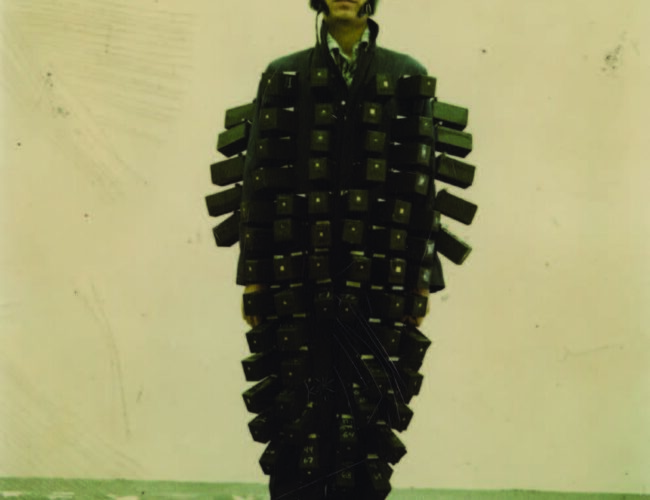Poetics of Light
Pinhole Photography
 Ben Conrad, Front view of Ben Conrad wearing pinhole suit and helmet with 130 cameras, 1994. Palace of the Governors Photo Archives, Pinhole Resource Collection HP.2012.15.1398.
Ben Conrad, Front view of Ben Conrad wearing pinhole suit and helmet with 130 cameras, 1994. Palace of the Governors Photo Archives, Pinhole Resource Collection HP.2012.15.1398.
BY KATE NELSON
In an age when every cell phone can take a respectable picture, cameras as low-tech as an oatmeal box still beguile a legion of practitioners, both artistic and documentarian. With roots in the ancient discovery of the camera obscura, pinhole photography has enchanted artists from the 1880s through today.
Poetics of Light: Pinhole Photography, opening April 26 at the New Mexico History Museum, explores a historical art form that exemplifies thoroughly contemporary ideals: do-it-yourself handmade technology with a dash of steampunk style.Nearly 225 photographs and forty cameras show how a light-tight box pierced by a hole and holding a piece of old-school film can reveal alternate versions of reality. At heart, photography is a method of capturing the way that light plays upon objects, the seen and the unseen—a visual form of poetry that extends beyond a literal representation whenever pinhole cameras are involved.
Poetics of Light offers a premiere of original prints by photo-graphers from around the world. Drawn from the holdings of the Pinhole Resource Collection, the body of work was amassed by co-curators Eric Renner and Nancy Spencer in San Lorenzo, in New Mexico’s Mimbres Valley. Seeking a permanent repository and impressed by the capabilities of the Photo Archives at the Palace of the Governors, the couple donated the collection—more than 6,000 photographs, sixty cameras, and hundreds of books—to the New Mexico History Museum in 2012.The exhibit’s opening coincides with Worldwide Pinhold Photography Day, a global event in which pinhole aficionados post their of-the-moment images to a website, thus celebrating in a high-tech way their mastery of low-tech photography.
Cameras on display in the exhibit range from machined beauties to reworked everyday objects, including a powder-puff container, a Boraxo can, a Campbell’s soup can and, yes, a Quaker Oats box. One of the most elaborate is a suit and helmet that, in 1994, photographer Ben Conrad covered with 130 cameras. After donning it, he had helpers cover him with a tarp, then remove it for twenty- to thirty-second exposures, the results of which will be arrayed behind the suit.
Some of the cameras used standard pinprick-sized holes for a “lens.” Others used slits or even body parts. In 1992, Jeff Guess placed film in the back of his mouth, then formed a pinhole with his lips. What the cameras lack is most photographers’ nightmare: no lens, no light meter, no viewfinder, no way of knowing precisely what kind of photo will emerge. “That randomness appeals to me,” said Photo Archivist Daniel Kosharek, who helped curate the exhibit with Renner and Spencer. “You go out there and expose what you think you’re going to take and when you get the film back it’s like, I took that? There’s a lot of quirkiness inherent in the process that ends up in the pictures.”
One part of the exhibit explores how scientists have employed pinhole photography, including several examples from Los Alamos National Laboratory: Julian Mack’s 1945 pinhole exposure of the first atomic bomb test in New Mexico and Richard Blake’s 1960 x-ray photo of the sun. Other photos reveal ethereal takes on world events: Chris Dreier’s 2010 image of the remnants of Nicolae Ceau¸sescu’s Romanian Palace; Marcus Kaiser’s 1990 images taken through holes in the collapsing Berlin Wall; and Harlan Wallach’s 1994 series on murder sites in Chicago.
Still others explore a fantasy world, such as Bethany DeForest’s Rosetvliders. Such dreamscapes join portraits, landscapes, still lifes, and figure studies in ways that are sometimes whimsical, distorted, or even unsettling. In a pinhole photograph, the exhibition asserts, everything we know about the world is suddenly altered, and we have to ask: Whose view of the world has the camera revealed?
The photographs play out in black-and-white, as well as color, and feature a range of alternative printing techniques including modern tintypes, silver gelatin prints, and more. In a companion book for the exhibit published by the Museum of New Mexico Press, Renner and Spencer wrote that photographs were selected for the exhibit in part “to show the mystery inherent in pinhole images, which express reality very differently from imagery made using cameras with lenses. Although describing the mystery of pinhole images is difficult, the concepts of soul, depth, yearning, timelessness, and archetypal feeling all contribute to the kind of visual reality produced, one perhaps only seen in a dreamlike state.”
The exhibit space will include several examples of camera obscuras. Educational materials will be available to teachers, and all visitors can take home instructions for building a pinhole camera or a pinhole viewer. Family activity days and supporting lectures will further celebrate the many ways that pinhole photography interprets—and sometimes inverts—our sense of how we see and what really exists.
Kate Nelson is Marketing Manager for the New Mexico History Museum and author of the biography Helen Hardin: A Straight Line Curved.




